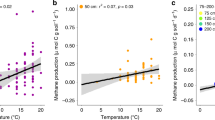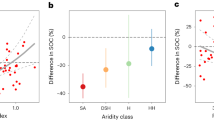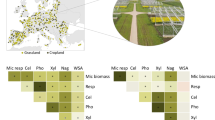Abstract
Global concerns for desertification have focused on the slow recovery of extensive and expanding drylands following disturbance, which may be exacerbated by climate change. Biological soil crusts (biocrusts) are photosynthetic soil communities found in drylands worldwide, which are central to the stability and resilience of dryland ecosystems, but vulnerable to global change. Here we use multiple decade-long experiments to investigate the consequences of climate and land-use change on biocrusts and soil stability. Biocrusts recovered rapidly under ambient temperatures but warming interacted with the precipitation disturbance to halt recovery. Moreover, warming alone caused losses of mosses, lichens and soil stability. Our results present a new mechanism contributing to land degradation in drylands whereby warming drives a state shift in biocrust communities, which degrades soil stability. The synergistic effects of climate and land-use change co-occur globally and our results support projections of increased desertification and lowered dryland resilience under warming.
This is a preview of subscription content, access via your institution
Access options
Access Nature and 54 other Nature Portfolio journals
Get Nature+, our best-value online-access subscription
$29.99 / 30 days
cancel any time
Subscribe to this journal
Receive 12 print issues and online access
$209.00 per year
only $17.42 per issue
Buy this article
- Purchase on Springer Link
- Instant access to full article PDF
Prices may be subject to local taxes which are calculated during checkout



Similar content being viewed by others
Data availability
Data generated during this study is available from the USGS ScienceBase-Catalog67.
Code availability
Code created for this study is available from the USGS ScienceBase-Catalog67.
References
Science Plan and Implementation Strategy IGBP Report No. 53/IHDP Report No. 19 (Global Land Project, 2005).
Millennium Ecosystem Assessment—Ecosystems and Human Well-Being: Desertification Synthesis Encyclopedia of the Anthropocene vols 1–5 (MEA, 2017).
Huang, J., Yu, H., Guan, X., Wang, G. & Guo, R. Accelerated dryland expansion under climate change. Nat. Clim. Change 6, 166–171 (2015).
Pimm, S. L. The complexity and stability of ecosystems. Nature 307, 321–326 (1984).
Tilman, D. & Downing, J. A. Biodiversity and stability in grasslands. Nature 367, 363–365 (1994).
Belnap, J. Surface disturbances: their role in acceleration desertification. Environ. Monit. Assess. 37, 38–57 (1995).
Zhao, Y., Jia, R. L. & Wang, J. Towards stopping land degradation in drylands: water-saving techniques for cultivating biocrusts in situ. Land Degrad. Dev. 30, 2336–2346 (2019).
Rodriguez-Caballero, E. et al. Dryland photoautotrophic soil surface communities endangered by global change. Nat. Geosci. 11, 185–189 (2018).
Coe, K. K. & Sparks, J. P. Physiology-based prognostic modeling of the influence of changes in precipitation on a keystone dryland plant species. Oecologia 176, 933–942 (2014).
Ferrenberg, S., Tucker, C. L. & Reed, S. C. Biological soil crusts: diminutive communities of potential global importance. Front. Ecol. Environ. 15, 160–167 (2017).
Belnap, J. & Gillette, D. A. Soil surface disturbance: impacts on potential wind erodibility of sand desert soils in SE Utah, USA. Land Degrad. Dev. 8, 355–362 (1997).
Rutherford, W. A. et al. Albedo feedbacks to future climate via climate change impacts on dryland biocrusts. Sci. Rep. 7, 44188 (2017).
Duniway, M. C. et al. Wind erosion and dust from US drylands: a review of causes, consequences, and solutions in a changing world. Ecosphere 10, e02650 (2019).
Ferrenberg, S., Faist, A. M., Howell, A. & Reed, S. C. Biocrusts enhance soil fertility and Bromus tectorum growth, and interact with warming to influence germination. Plant Soil 429, 77–90 (2018).
Eldridge, D. J. et al. The pervasive and multifaceted influence of biocrusts on water in the world’s drylands. Glob. Change Biol. 26, 6003–6014 (2020).
Ferrenberg, S., Reed, S. C. & Belnap, J. Climate change and physical disturbance cause similar community shifts in biological soil crusts. Proc. Natl Acad. Sci. USA 112, 12116–12121 (2015).
Reed, S. C. et al. Changes to dryland rainfall result in rapid moss mortality and altered soil fertility. Nat. Clim. Change 2, 752–755 (2012).
Concostrina-Zubiri, L. et al. Biological soil crusts across disturbance-recovery scenarios: effect of grazing regime on community dynamics. Ecol. Appl. 24, 1863–1877 (2014).
Weber, B., Bowker, M., Zhang, Y. & Belnap, J. in Biological Soil Crusts: An Organizing Principle in Drylands (eds Weber, B., Büdel, B. & Belnap, J.) 479–498 (Springer, 2016).
Reynolds, J. F. et al. Global desertification: building a science for dryland development. Science 316, 847–851 (2007).
Berdugo, M. et al. Global ecosystem thresholds driven by aridity. Science 367, 787–790 (2020).
Bestelmeyer, B. T. et al. Analysis of abrupt transitions in ecological systems. Ecosphere 2, e03360 (2011).
Bestelmeyer, B. T. et al. Desertification, land use, and the transformation of global drylands. Front. Ecol. Environ. 13, 28–36 (2015).
Beisner, B., Haydon, D. & Cuddington, K. Alternative stable states in ecology. Front. Ecol. Environ. 1, 376–382 (2003).
Fukami, T. & Nakajima, M. Community assembly: alternative stable states or alternative transient states? Ecol. Lett. 14, 973–984 (2011).
Belnap, J. & Büdel, B. in Biological Soil Crusts: An Organizing Principle in Drylands (eds Weber, B., Büdel, B. & Belnap, J.) 305–320 (Springer, 2016).
Belnap, J. & Warren, S. D. Measuring restoration success: a lesson from Patton’s tank tracks. Ecol. Bull. 79, 33 (1998).
Belnap, J. & Elderidge, D. in Biological Soil Crusts: Structure, Function and Management (eds Belnap, J. & Lange, O. L.) 363–383 (Springer, 2001).
Turner, M. G. Disturbance and landscape dynamics in a changing world. Ecology 91, 2833–2849 (2010).
Scheffer, M. & Carpenter, S. R. Catastrophic regime shifts in ecosystems: linking theory to observation. Trends Ecol. Evol. 18, 648–656 (2003).
Sala, O. E. & Lauenroth, W. K. Small rainfall events: an ecological role in semiarid regions. Oecologia 53, 301–304 (1982).
Cayan, D. R. et al. Future dryness in the Southwest US and the hydrology of the early 21st century drought. Proc. Natl Acad. Sci. USA 107, 21271–21276 (2010).
Christensen, N. S., Wood, A. W., Nathalie, V., Lettenmaier, D. P. & Palmer, R. N. The effects of climate change on the hydrology and water resources of the Colorado river basin. Clim. Change 62, 337 (2004).
Herrick, J. et al. Field soil aggregate stability kit for soil quality and rangeland health evaluations. Catena 44, 27–35 (2001).
Escolar, C., Martínez, I., Bowker, M. A. & Maestre, F. T. Warming reduces the growth and diversity of biological soil crusts in a semi-arid environment: implications for ecosystem structure and functioning. Phil. Trans. R. Soc. B 367, 3087–3099 (2012).
Scheffer, M. et al. Creating a safe operating space for iconic ecosystems: manage local stressors to promote resilience to global change. Science 347, 1317–1319 (2015).
Collins, S. L., Micheli, F. & Hartt, L. A method to determine rates and patterns of variability in ecological communities. Oikos 91, 285–293 (2000).
Rillig, M. C. et al. The role of multiple global change factors in driving soil functions and microbial biodiversity. Science 366, 886–890 (2019).
IPCC. Climate Change 2014: Impacts, Adaptations, and Vulnerability (eds Field, C. B. et al.) (Cambridge Univ. Press, 2014).
Mirzabaev, A. et al. in IPCC Special Report on Global Warming of 1.5 °C (eds Masson-Delmotte, V. et al.) Ch. 3 (WMO, 2018).
Torres-Cruz, T. J. et al. Species-specific nitrogenase activity in lichen-dominated biological soil crusts from the Colorado Plateau, USA. Plant Soil 429, 113–125 (2018).
Omernik, J. M. & Griffith, G. E. Ecoregions of the conterminous United States: evolution of a hierarchical spatial framework. Environ. Manag. 54, 1249–1266 (2014).
Kuske, C. R., Yeager, C. M., Johnson, S., Ticknor, L. O. & Belnap, J. Response and resilience of soil biocrust bacterial communities to chronic physical disturbance in arid shrublands. ISME J. 6, 886–897 (2011).
Tucker, C. L., Ferrenberg, S. & Reed, S. C. Climatic sensitivity of dryland soil CO2 fluxes differs dramatically with biological soil crust successional state. Ecosystems 22, 15–32 (2018). https://doi.org/10.1007/s10021-018-0250-4
Cable, J. M. & Huxman, T. E. Precipitation pulse size effects on Sonoran Desert soil microbial crusts. Oecologia 141, 317–324 (2004).
Karl, T. R., Knight, R. W. & Plummer, N. Trends in high-frequency climate variability in the twentieth century. Nature 377, 217–220 (1995).
Kunkel, K. E., Easterling, D. R., Redmond, K. & Hubbard, K. Temporal variations of extreme precipitation events in the United States: 1895–2000. Geophys. Res. Lett. 30, 1895–2000 (2003).
Kim, J. A projection of the effects of the climate change induced by increased CO2 on extreme hydrologic events in the Western US. Clim. Change 68, 153–168 (2005).
Smith, S. J. et al. Climate change impacts for the conterminous USA: an integrated assessment part 1. Scenarios and context. Clim. Change 69, 7–25 (2005). https://doi.org/10.1007/1-4020-3876-3_2
Schwinning, S., Belnap, J., Bowling, D. R. & Ehleringer, J. R. Sensitivity of the Colorado Plateau to change: climate, ecosystems, and society. Ecol. Soc. 13, 28 (2008).
Daly, C. et al. Physiographically sensitive mapping of climatological temperature and precipitation across the conterminous United States. Int. J. Climatol. 28, 2031–2064 (2008).
Jonasson, S. The point intercept method for non-destructive estimation of biomass. Phytocoenologia 11, 385–388 (1983).
R Core Team. R: A Language and Environment for Statistical Computing (R Foundation for Statistical Computing, 2019).
Wickham, H. ggplot2: Elegant Graphics for Data Analysis (Springer-Verlag, 2016).
Oksanen, A. J. et al. Vegan: Community Ecology Package. Rpackage version 2.5-7 https://CRAN.R-project.org/package=vegan (2020).
Anderson, M. J. A new method for non-parametric multivariate analysis of variance. Austral Ecol. 26, 32–46 (2008).
Venables, W. & Ripley, B. Modern Applied Statistics with S. (Springer, 2002).
Lenth, R., Singmann, H., Love, J., Buerkner, P. & Herve, M. Package ‘emmeans’ https://github.com/rvlenth/emmeans (2018).
Signorell, A. DescTools: Tools for Descriptive Statistics (2021).
Hallett, L. M. et al. codyn: an R package of community dynamics metrics. Methods Ecol. Evol. 7, 1146–1151 (2016).
Wood, S. N. Generalized Additive Models: An Introduction with R 2nd edn 1–476 (CRC/Taylor & Francis, 2017).
Bürkner, P. C. brms: an R package for Bayesian multilevel models using Stan. J. Stat. Softw. 80, 1–28 (2017).
Gelman, A. & Rubin, D. B. Inference from iterative simulation using multiple sequences. Stat. Sci. 7, 547–511 (1992).
Vehtari, A., Gelman, A. & Gabry, J. Practical Bayesian model evaluation using leave-one-out cross-validation and WAIC. Stat. Comput. 27, 1413–1432 (2017).
Modrák, M., Barrett, M., Weber, F. & Coronado, E. bayesplot: Plotting for Bayesian Models. R package version 1.8.0 https://mc-stan.org/bayesplot/ (2021).
Makowski, D., Ben-Shachar, M. & Lüdecke, D. bayestestR: describing effects and their uncertainty, existence and significance within the Bayesian framework. J. Open Source Softw. 4, 1541 (2019).
Phillips, M. L., Howell, A., Lauria, C. M., Belnap, J. & Reed, S. C. Data and software code from two long-term experiments (1996–2011 and 2005–2018) at three sites on the Colorado Plateau of North America (US Geological Survey, 2021); https://doi.org/10.5066/P9RUN1TP
Acknowledgements
We are indebted to the many field technicians that helped with the project, E. Grote for plot instrumentation and quality control, E. Geiger for research station leadership and C. Collins and T. Bohner for help with statistical analyses. We also thank M. Van Scoyoc, T. Fisk, J. Jew, L. Wilkolak, the National Park Service Southeast Utah Group and the Bureau of Land Management Canyon Country District Office for expert assistance with permits and logistics. Any use of trade, firm or product names is for descriptive purposes only and does not imply endorsement by the US government. Funding: this research was supported by the Office of Science (Office of Biological and Environmental Research) US Department of Energy Terrestrial Ecosystem Science programme (J.B. and S.C.R), the US Geological Survey and a National Science Foundation Postdoctoral Research Fellowship (award ID 2109655; M.L.P.).
Author information
Authors and Affiliations
Contributions
J.B. acquired financial support and established the field projects. S.C.R. acquired financial support and provided overall direction of the field operation. A.H. and C.M.L. collected biocrust community data in the field and maintained the climate manipulation experiment. M.L.P. and B.E.M. analysed the data. M.L.P acquired financial support and wrote the initial draft of the manuscript. All authors contributed to the synthesis of data and the final manuscript.
Corresponding author
Ethics declarations
Competing interests
The authors declare no competing interests.
Additional information
Peer review information Nature Climate Change thanks Paolo D’Odorico, Miguel Berdugo and the other, anonymous, reviewer(s) for their contribution to the peer review of this work.
Publisher’s note Springer Nature remains neutral with regard to jurisdictional claims in published maps and institutional affiliations.
Supplementary information
Supplementary Information
Supplementary Figs. 1–9, Tables 1–15 and Methods.
Rights and permissions
About this article
Cite this article
Phillips, M.L., McNellis, B.E., Howell, A. et al. Biocrusts mediate a new mechanism for land degradation under a changing climate. Nat. Clim. Chang. 12, 71–76 (2022). https://doi.org/10.1038/s41558-021-01249-6
Received:
Accepted:
Published:
Issue Date:
DOI: https://doi.org/10.1038/s41558-021-01249-6
This article is cited by
-
A realized facilitation cascade mediated by biological soil crusts in a sagebrush steppe community
Scientific Reports (2023)
-
Dual use of solar power plants as biocrust nurseries for large-scale arid soil restoration
Nature Sustainability (2023)



